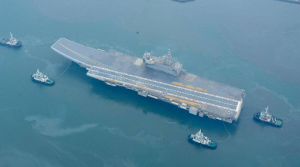26 Aug Aircraft carrier: INS Vikrant
Context :
The carrier is set to be commissioned on September 2 in the presence of Prime Minister Narendra Modi.
About the aircraft carrier Vikrant

-
- INS Vikrant is India’s first Indigenous aircraft carrier (IAC-1), a part of Atmanirbhar Bharat, It is a shining example in the nation’s quest for ‘Atma Nirbhar Bharat’ and ‘Make in India Initiative,’ with more than 76 percent indigenous content.”.
- INS Vikrant was named after the warship that played a crucial role in the 1971 war.
- It is designed: By the Indian Navy’s Directorate of Naval Design (DND), the carrier was built at Cochin Shipyard Limited, a public sector shipyard under the Ministry of Shipping.
- Vikrant will be the fourth aircraft carrier to be operated by the Indian Navy – the first Vikrant (British origin) from 1961 to 1997.
- INS Viraat (British origin) from 1987 to 2016 and INS Vikramaditya (Russian origin) from 2013 onwards.
- It is the largest and most complex warship ever to be designed and built in India.
What are the features of INS Vikrant?
- It has expected to have a top speed of around 28 knots and a cruising speed of 18 knots with an endurance of about 7,500 nautical miles.
- The ship can accommodate an assortment of fixed-wing and rotary aircraft.
- It has over 2,300 compartments, designed for a crew of around 1,700 people, including specialised cabins to accommodate women officers.
- The ship includes Barak LR SAM and AK-630, while it has MFSTAR and RAN-40L 3D radars as sensors. The vessel has a Shakti EW (Electronic Warfare) Suite.
How it will help?
- INS-Vikrant will inflate peace, security and stability in the Indian Ocean and Indo-Pacific Region.
- The combat capability, reach and versatility of the aircraft carrier will add formidable capabilities in the defence of the country and help secure India’s interests in the maritime domain.
- It would offer an incomparable military instrument with its ability to project air power over long distances, including air interdiction, anti-surface warfare, offensive and defensive counter-air, airborne anti-submarine warfare and airborne



No Comments